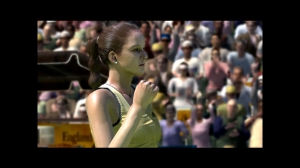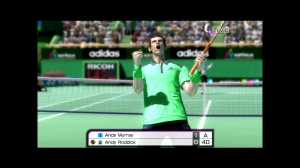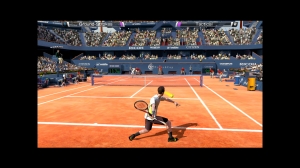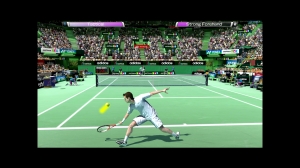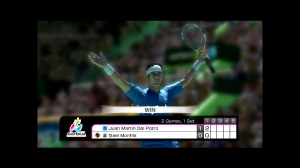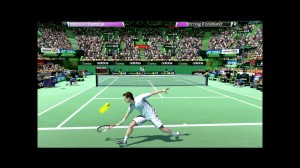 Tommy Haas must love when a Virtua Tennis game is released. As the only player to appear in Virtua Tennis 1-4, Tommy Haas seems to get an extra spring in his step each year Sega publishes a new iteration and shows it by having the best seasons of his career. In fact, his last tournament victory happened the same year as the release of Virtua Tennis 2009, the previous game in the series, even though he didn’t make the roster. And yet, despite a long career that has included 13 titles and an Olympic silver medal, no tennis fan can speak of Tommy Haas without mentioning his unfulfilled potential and lack of major victories.
Tommy Haas must love when a Virtua Tennis game is released. As the only player to appear in Virtua Tennis 1-4, Tommy Haas seems to get an extra spring in his step each year Sega publishes a new iteration and shows it by having the best seasons of his career. In fact, his last tournament victory happened the same year as the release of Virtua Tennis 2009, the previous game in the series, even though he didn’t make the roster. And yet, despite a long career that has included 13 titles and an Olympic silver medal, no tennis fan can speak of Tommy Haas without mentioning his unfulfilled potential and lack of major victories.
It’s strangely fitting, then, that Virtua Tennis 4 on the Playstation Vita, like the franchise, has mirrored Haas’ career path. After an inspired first entry in the franchise that singlehandedly reinvigorated the tennis genre, Virtua Tennis has failed to improve in any meaningful way more than a decade later. Obviously, this is a sports franchise, and there’s only so much that can be done with the static game of tennis. Any criticism of the series must take this into account.
The standard Virtua Tennis gameplay is back here with one significant change: While players have always been categorized by their strength (defense, ground strokes, big server), it now comes with a meter that increases every time a player accomplishes an action related to his or her strength. When this meter is full, a player is able to trigger a cinematic and hit a faster, more powerful Super Shot, much like Mario Tennis. It’s not a terrible change, but it feels both unoriginal and out of place in Virtua Tennis, a series that has managed to avoid going over-the-top in its actual tennis matches until now. The rest of the game remains true to the series, affording players a meter-based serving system and four other types of shots (top spin, slice, lob, and drop).
Most of all, it’s the presentation and replayability where Sega falters in Virtua Tennis 4. The main focus of Virtua Tennis has always been its RPG-esque campaign, or World Tour, mode, where a player creates a character, using him or her to participate in tournaments and level up through silly minigames. Fans of Virtua Tennis will either be relieved or disappointed to know that not much has changed otherwise, to the series’ detriment. Everything outside of matches or minigames is nothing more than window dressing. Coaches and fellow players offer nothing but superficial banter, and fans give nothing but empty platitudes. What felt fresh in 1999 feels tedious in 2012.
Players have quite a bit to customize in outfits and can thankfully ditch the painfully short shorts on their male players quickly enough. There is a fair amount of patterns and types of clothing to choose from, but most unlockables simply change the color of existing clothing. Body customization is basic, rudimentary, and disappointing, as a player cannot change much below the neck other than height and weight.
In a bit of lateral movement, the World Tour interface is different, allowing players to traverse the map through a board game format. Players can only move to certain squares based on the number of spaces on the movement tickets in their possession. For the most part, all this effectively does is take a little control out of the player’s hands over what activity he or she can do each week, which isn’t necessarily a bad thing and even adds a little strategy. It doesn’t affect the single-player much one way or the other.
The Vita version adds some unique functionality to the game, taking full advantage of the Vita’s capabilities for better or worse. Players can map their faces to their created characters through the Vita’s camera. Unfortunately, I must issue this warning: I was unable to produce anything that didn’t resemble an abomination of nature that both my friends and I wanted to burn with fire. I firmly believe this says more about how poorly implemented the feature is than my own looks (I think).
As is expected with the Vita, touchscreen controls are present here, though even Sega seems to imply these are half-baked in the instruction manual, encouraging players to “try combining control types” by using the stick for movement and the touchscreen for hitting the ball. This is for very good reason: swiping is both the command for hitting the ball and moving. My player frequently moved forward after hitting a simple ground stroke. Using the stick for movement didn’t help matters. Buttons are clearly the method to use for this game in the long run.
The other Vita features are forgettable. Sega’s included a first-person mode where a player turns using the Vita’s motion controls, a minigame where a player moves targets to hit using the motion controls, and a strange mode that overlays Virtua Tennis models over pictures taken with the Vita camera. If anyone reading this has been dreaming of posing next to a virtual Boris Becker, now is your chance!
Speaking of the roster, it includes most of the big names in tennis. Djokovic, Nadal, Federer, and Murray are all present and accounted for on the men’s side. The women’s side is a bit more lacking, but it manages to include Venus Williams, Caroline Wozniacki, and Maria Sharapova, improving over Virtua Tennis 3’s debacle, where two fictional female players were included over the hundreds left over in the WTA. Still, the game failed to secure any female players who have won a Grand Slam since 2008 and should be docked for that. A tiny handful of legends are playable as well.
The tournament lineup includes knockoffs of existing names (e.g. French Cup for French Open). This hurts the experience more in tennis than other sports (excluding golf), since the familiar locations of the major tournaments adds to the sport’s mystique and grandeur.
The graphics get the job done, though Sega still hasn’t learned how to make good-looking grass. Either that or the ATP has decided to use Astroturf instead of grass for the upcoming season. Players mostly look as they should. The music is standard Virtua Tennis fare, and the sound effects are top-notch.
Online play is rather inconsistent. I had several matches that were completely unbearable; my player would react a half-second after I pressed a button. Others were mostly smooth except for serving, which was always strangely laggy no matter what I did. It’s not the worst and is adequate for those looking to hone their skills around the world. The party modes that accompany multiplayer on other consoles are not present here.
Virtua Tennis is a series that has failed to innovate on any significant level since its 1999 introduction. At its core, Virtua Tennis 4 is a polished game and will hold the interest of tennis fans that have never experienced the series. For everyone else, this game doesn’t take the necessary steps to improve a player’s experience in both single and multiplayer. The core gameplay is solid as it ever was, but there’s no compelling reason to experience it again this time around. Perhaps Sega is just waiting for Tommy Haas to finally win a major before they give this series the makeover it deserves.
…If that’s the case, we’re probably going to be waiting for an awfully long time.
Gameplay
Graphics
Sound
Overall


